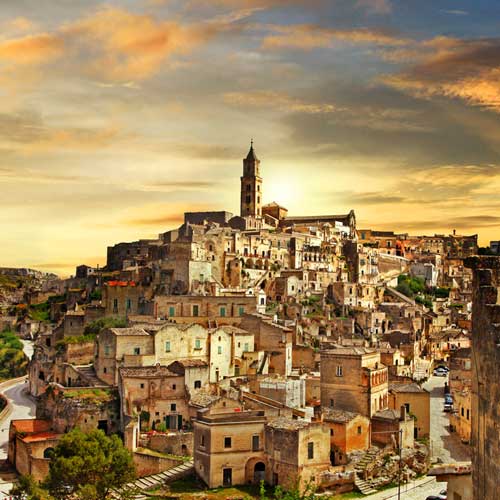This is our Italy, this is Mangiatorella
Imagine Michelangelo, Sofia and their children Marcello and Silvia who are strolling around the enchanting lanes of a medieval village, where the balconies are ablaze with the colour of geraniums and the women are sitting outside the doors of their homes, embroidering and breathing a little fresh air.
Imagine two old friends in shirtsleeves, sitting at the bar playing a game of cards, imagine the witty comments of Luigi and the laughter of Leonardo, imagine how being in company puts them in an optimistic good mood.
Imagine Francesco, a good-looking young man, tall and slim, climbing on his father’s old motorbike after restoring it to new, imagine his pride in showing it to Maria, a brunette with large black eyes.
Imagine a sunny day, a garden and a patio with a table crowded with diners celebrating a wedding, imagine grandfather who, sipping a glass of fresh water, is recounting his memories to the little ones, who are listening transported.
This is our Italy, this is our philosophy of life. A philosophy based on love, simplicity, company, wellbeing, cheerfulness and tradition. A life that every day rediscovers the pleasure of enjoying what nature best offers.
Such as Mangiatorella, the still mineral water known in Italy since the 1800s for its superior quality. Drinking Mangiatorella Mineral Water means slaking one’s thirst with a delicate, harmonious and cool taste, it means choosing a light water, which cleans the palate and heightens the flavour of food and, thanks to its precious natural elements, aids digestion.

THE LOVE FOR PASTA AND BREAD
Already the Etruscans, a people of ancient Italy, prepared pasta and often the Romans, before going to the Colosseum, ate strips of pasta made of flour ad water, the first lasagne.
Steadily pasta has become more widespread, and was called by various names, until the Neapolitans adopted the name macaroni, which became famous throughout the world. In Italy pasta is exalted in spaghetti with tomato sauce and basil.
Here is a traditional recipe: lightly brown a garlic clove in a pan with 50 g of extra-virgin olive oil, blend 500 g of ripe tomatoes cut into cubes with some basil leaves, stir for a few minutes, add salt to taste and turn off the heat; boil 5 litres of water in a pan, add about 30 g of salt, insert 360 g of Italian spaghetti, respect the cooking time on the packet, drain and place on four plates; after a little heating add the sauce, a tablespoon of raw olive oil and a basil leaf.
Since the time of the Roman Empire bread has been one of the most-loved daily foods, and for centuries Italians baked it at home, as many Italian grandmothers and mothers still do today.
The bruschetta emerged from bread, a dish invented many years ago by countrymen in order to use bread for a long, and at one time the bruschetta consisted of a slice of toasted bread, on which garlic was rubbed, and which then was sprinkled with olive oil and salt.
Today the bruschetta can be prepared with an infinity of ingredients, such as tomato and mozzarella, well-known delights of the Italian cuisine.
Would you like to prepare a bruschetta alla caprese? There is nothing easier: just toast (in the oven or in a pan) some slices of Italian bread made of durum wheat, rub it with garlic, and place small pieces of mozzarella on them, cherry tomatoes, basil, oregano, whole black olives, salt and a trickle of extra-virgin olive oil.
The Vespa and the love for freedom
It is difficult to condense Italian taste, flair and creativity into one object, but if it were possible, that object would be the Vespa, the famous scooter by Piaggio patented in 1946 and which became famous throughout the world in the ’50s after having been mounted by Gregory Peck and Audrey Hepburn in the celebrated film ‘Roman Holiday’.
With 17 million sales, the Vespa was a unique phenomenon of custom, even being exhibited in the design, modern art, science and technology and transport museums of many countries and even now making up part of the permanent collection of the MoMa of New York.
But besides being an object, for whole generations of youths the Vespa was – and still is – a veritable symbol of freedom, of independence, and of love of the open-air life.

The genuine beauty of the ancient villages
In Italy, nature has been generous and its fascinating territory abounds in places with a wealth of immense parks, crystalline coasts, and stupendous mountains.
Making the Italian peninsula even more beautiful, there are cities of art and atmospheric historic burghs, often clinging to crags, set among the rocks, or lying in green valleys, and which characterise the landscape from the Val d’Aosta to Sicily, making it unique.
These places – many of which have been designated the Heritage of Mankind by UNESCO – take the breath away owing to their architectural, artistic and historic treasures which safeguard: castles, towers, mills, lanes, bell towers, bridges, gardens, churches, aristocratic mansions, museums and much more.
There are many Italians who love to live in these small towns, to assimilate the genuine beauty and peace on a daily basis, to cultivate friendships, to enjoy the tasty fruits of the surrounding countryside.
Just a simple stroll around these small towns is a wonderful experience, which the very many visitors from all over the world take away with them for the rest of their lives.





